Sometime in mid 1921 the theatrical costume designer Dolly Tree became associated with the famous Cornish textile company Crysede and the owner Alec Walker.
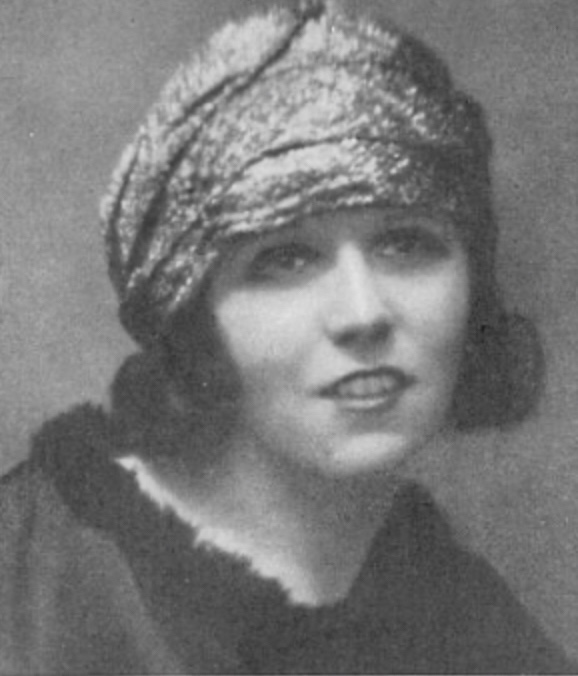
There were adverts placed in several major London magazines such as The Queen, Ladies Field, The Tatler and the Sketch that featured Crysede’s Super Vigil Silk. The adverts stated ‘we have an entirely new and exclusive collection of these famous silks in hitherto unknown colorings, beautiful shot stripes, reminiscent of nature’s various moods – ‘Ripe Corn’, ‘Southern Spring’, ‘Cornish Mist’, ‘Violet Dawn’ are the names of just a few. With each stripe is an attractive shot color to match; also you would be delighted with the new women floral designs, having the appearance of old-world tapestries with all the lightness and daintiness of silk. Significantly, a free booklet was available featuring exclusive frocks designed by Miss Dolly Tree using, and to show-case, Crysede’s Super Vigil Silk.
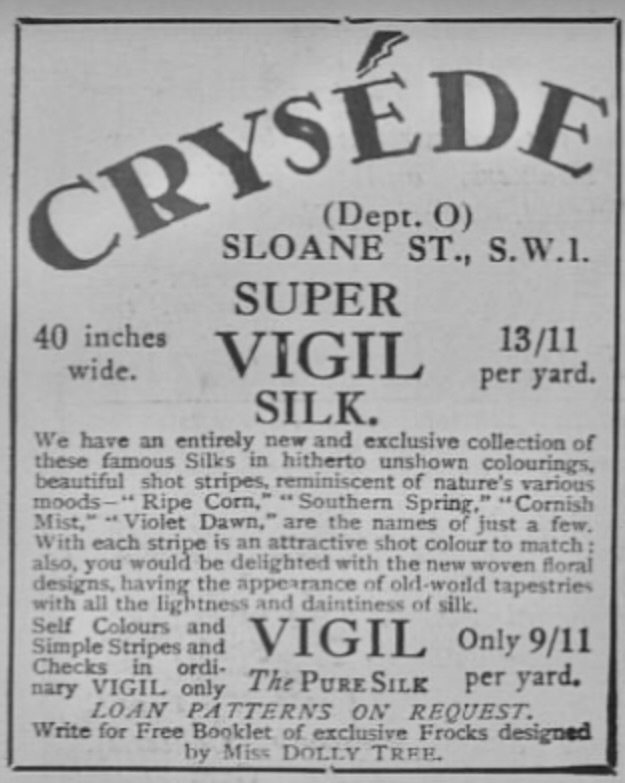
At the same time various adverts were placed in the local press in Cornwall promoting Crysede and Dolly Tree’s involvment.
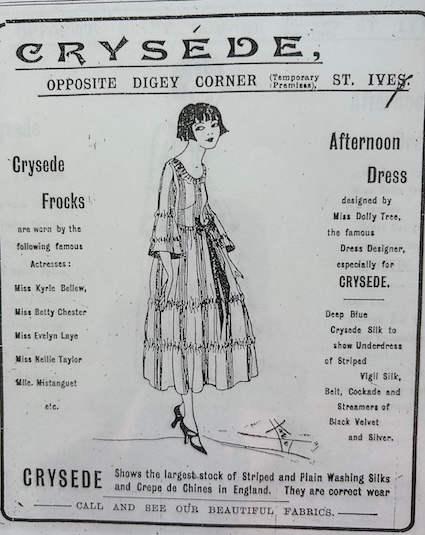

Crysede was created by Alec Walker (1889-1964) in 1920 when Walker married Kay Earle and moved to Newlyn in Cornwall from Yorkshire. But the origins of the company had been gestating before the First World War when Walker had started a business producing Vigil Silk in Yorkshire. He also opened a small shop in Sloane Street, London. The business flourished in Cornwall and Walker immersed himself in the Newlyn and London art scenes. In 1919 and 1920 Walker used the modernist artist Edward McKnight Kauffer and the commercial Horace Taylor to create stunning artworks for advertisements and later used the equally talented artist S.S. Longley.
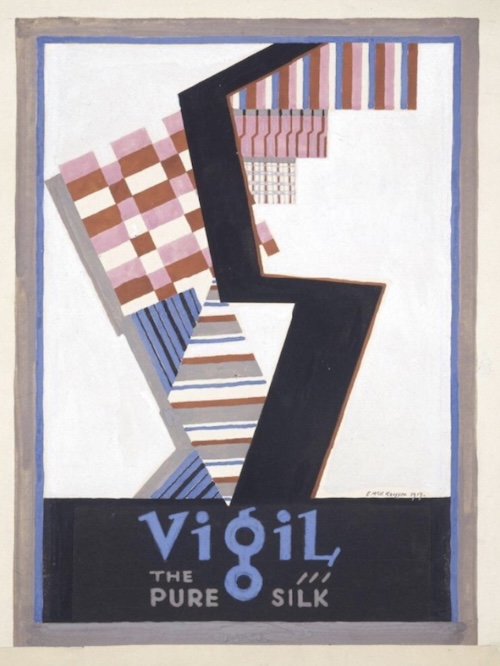
See the post on SS Longley here
Crysede was a brand that was targeted at the modern, middle class woman with an eye for cutting-edge design and colour. In 1923 Walker went to Paris to meet Raoul Dufy with the intention of buying his textile designs which he could not afford. But Doufy and the sculptor Ossip Zadkine encouraged Walker to use his own colorful artworks inspired by the Cornish landscape for his textiles. I would argue that Walker may well have visited Paris before 1923 and most likely after the end of the First World War, simply because Paris was viewed as the design centre of Europe and an irresistible magnet.
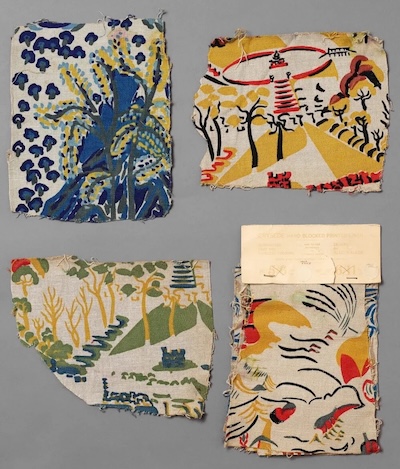
The association with Crysede and Alec Walker came at a time when Dolly Tree was firmly establishing herself as a major stage costume designer both in London, Paris and elsewhere. She had already been working for the theatrical producer Julian Wylie during the period 1918-1920 creating sets and costumes for his regional shows. She had also contributed to the Folies Bergere in Paris in 1920. In 1921 her work continued for Julian Wylie and she contributed to the revue Tout Fue, Tout Femme at the Concert Mayol in Paris, in early 1921. In April 1921 she costumed her first London West End show with Julian Wylie’s Peepshow at the Hippodrome. Thereafter, Dolly Tree’s credits proliferated. It was at this point in time that she worked for Crysede.
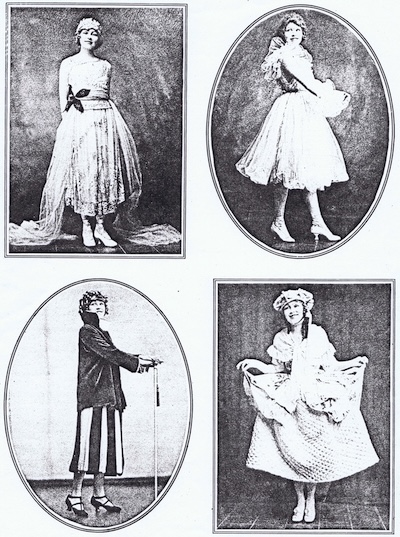
See the interview with Dolly Tree in the Daily Express from January 1922 here
However, how did Dolly Tree meet Alec Walker and how did she become involved with Crysede? By mid-1921 Dolly Tree had already established a reputation as an artist of great skill designing costumes and gowns for the stage and artwork for newspapers and magazines and theatrical programmes and posters. It might be that in her capacity as a dress designer Dolly Tree had to source fabrics and simply became aware of Crysede and Vigil Silks and used them for some of her stage costumes. In later interviews she said that ‘hunting for materials is a lovely task’ and mentioned that ‘it is necessary to know all there is to know about materials, their cost, width and above all how they will look in the limelight.’ Equally, Walker may have seen Dolly Tree’s costumes in Paris at the Folies Bergere or the Concert Mayol.
Interestingly, in the summer of 1920, a year before the association between Dolly Tree and Crysede seemingly began, Dolly Tree had been providing illustrations for the quirky magazine called Pan. These included a series of sketches she had made of gowns and outfits seen at well-known London couture establishments. The sketches are totally comparable to one of Dolly Tree’s sketches seen in an advertisement for Crysede. She was clearly out and about in London and immersed in both the London and Paris fashion scenes.
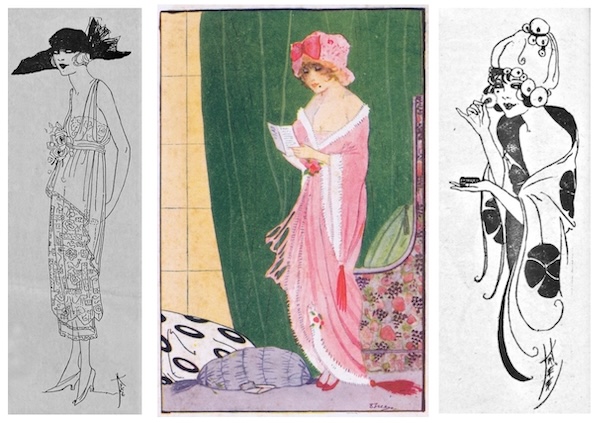
To top all of this I remembered a fascinating story about Dolly Tree and what was called a slumber suit from 1917 which equally might have some relevance. At the time Dolly Tree was appearing as an actress in British Silent film. On a page dedicated to women called Vanity the writer visited Dolly Tree to see her latest fashion creation – a hand painted Slumber suit. Thus named because it was thought Pajamas was an ugly word and a slumber suit more becoming and delightful. The writer was prepared for something ‘out of the ordinary for had not she designed and created the garment herself? And, is not Dolly Tree one of the most original and ingenious of all the artistic folk I have ever met?’
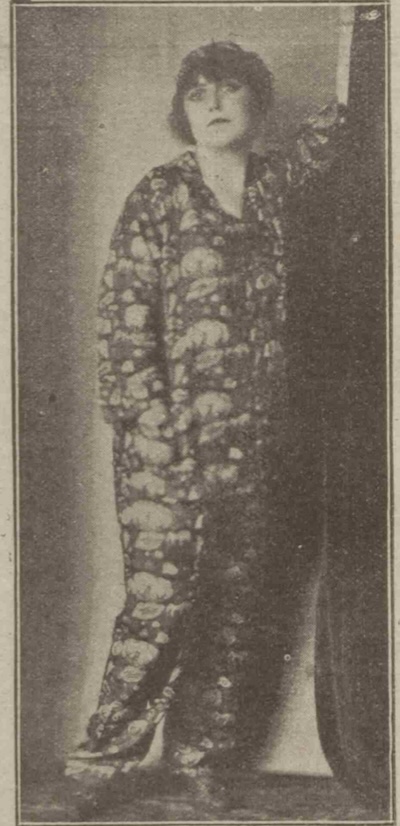
The reality was apparently ‘positively amazing’ and ‘daring’. The slumber suit was of black silk but hand painted in brilliant mauve, emerald, rose and white representing futurist flowers with an emerald chiffon frill. It was thought that it might well feature on the silent screen.
It is also known that Alec Walker had his eye on what has happening in the world of art, textiles and fashion in terms of new developments and styles. He also mixed in avant-garde artistic circles in London and elsewhere. He may have been introduced to Dolly Tree or sought her out. Given her noticeable profile with an innovative, unique and avant garde style he swiftly realized there was a synergy between them and that this would lead to a mutual beneficial business opportunity. Indeed, Janet Axten, the authority on the history of Crysede observed that Alec Walker ‘was the consummate publicist. Anything to grab the headlines.’
Given that Alec Walker’s wife Kathleen (Kay) Earle was recognized as Crysede’s designer, the collaboration with Dolly Tree is interesting and must reflect a move to broaden the design base for the company and introduce another dimension in terms of publicity and allure. Also, Janet Axten made clear that Alec and Kay’s first daughter was born in 1921, and it may be that during 1921 Kay was doing less designing and so there was a need for another designer.
It is not surprising then, that in the Crysede adverts, Dolly Tree was described as ‘the famous dress designer.’ But it must be worth remembering the publicity angle was a twist. Dolly. Tree did not design the fabrics themselves (clearly done by Alec and Kay) but she molded the fabrics into the latest fashion creations to illustrate how the fabrics could be used effectively.
Dolly Tree’s involvement is likely to have been the first known ‘outside’ designer to work with Crysede. Her collaboration pre-dates the known association with the designer George Criscoulo in the late 1920s.
It is also worth mentioning that a little later in the spring of 1923 Dolly Tree’s designs were also seen in the Folies Bergere show En Pleine Folie. One of the scenes she dressed was Les Nuits du Boi (Night in the Woods). For this evocative nocturnal excursion into the woods she created a range of gowns for Les Excites and the fabric was comprised of patterned Lyon silk for Maison Walmart located at 25 Place Vendome in Paris. The relevance and connection is obvious.
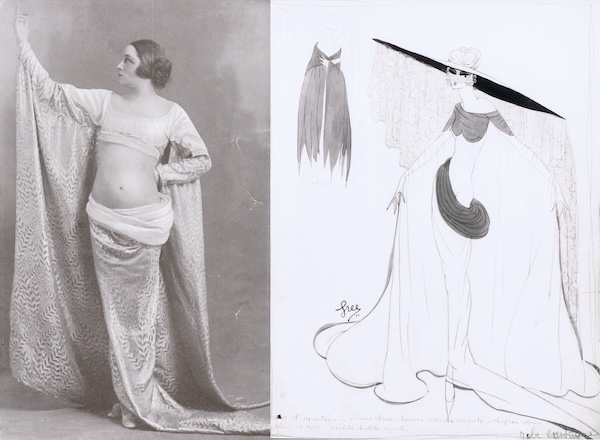
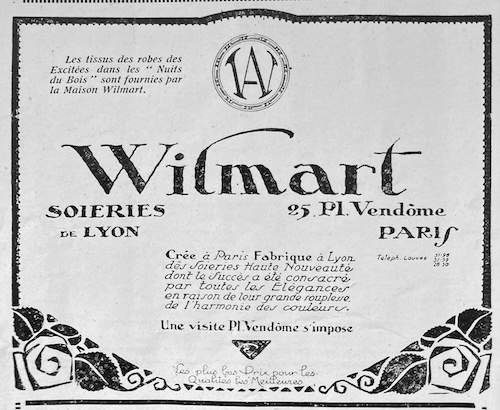
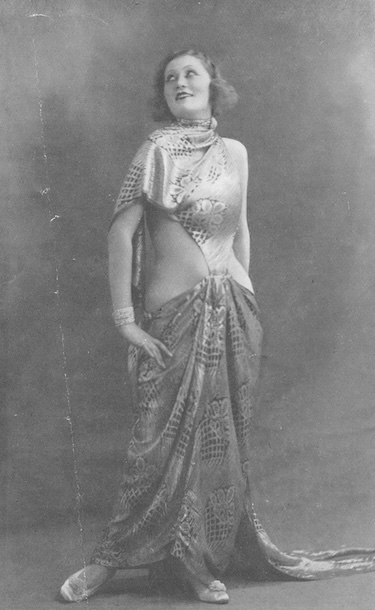
By 1921, in addition to the shop in London. Crysede had three shops in Cornwall (Penzance, St Ives and Falmouth) and opened another shop in Bath in 1922. In 1926 Tom Heron joined the company as manager and the production facilities moved from Newlyn to St Ives in 1926 although Alec Walker and his wife continued their design work in Newlyn. At some point in the late 1920s the London designer George Criscoulo (who had made his name as an illustrator and then as a designer for the theatrical producer Harry Day on his regional revues that were also staged at the London Palladium). After a divorce from Kay in 1929 there was some internal turmoil at Crysede. Heron left the company and Alec Walker also left Crysede in 1933 and moved back to Yorkshire breeding cattle. Crysede was liquidated between 1939-1941 but left an amazingly rich legacy.
Dolly Tree went from strength to strength, designing for many London and Paris stage show and other revues throughout Europe. She ventured into designing costumes for the British Film Industry with the groundbreaking film Woman to Woman (1923) working alongside Graham Cutts, Alfred Hitchcock and Michael Balcon. She also became sole designer for the London modiste Peron Couture and she became well-known as a designer for cabaret shows at all the main venues including the Hotel Metropole, Grafton Galleries, Queen’s Hall Roof, Piccadilly Hotel and the New Princes. In 1926 she moved to New York and eventually in 1930 to Hollywood where she ultimately became a designer for MGM.
All images (unless specified in the caption) and text © copyright Gary Chapman / Jazz Age Club and must not be re-used without prior consent
Sources
Dolly Tree: A Dream of Beauty by Gary Chapman
Crysede – The Unique Textile Designs of Alec Walker by Hazel Berriman
https://www.meg-andrews.com/articles/Alec-Walkers-Crysde-Company-/13/1
https://thelovewhatyouwearproject.blogspot.com/2013/10/penlee-house-museum-in-search-of-crysede.html
https://salisburymuseum.wordpress.com/tag/crysede/
Email from Janet Axten
Picturegoer 3/2/1917
Ladies Field 28/5/1921
The Queen 4/6/1921 and 18/6/1921
Ladies Field 9/7/1921
The Tatler 15/5/1921, 18/5/1921, 1/6/1921 and 29/6/1921
The Sketch 25/5/1921
The Evening News 1/12/1924
Pearson’s Magazine December 1923

